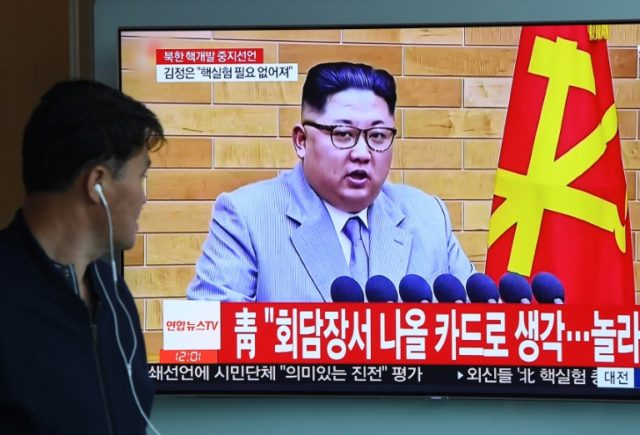Seoul (AFP) – North Korea will destroy its nuclear test site later this month, ahead of a summit with the United States, it said Saturday, blowing up its tunnels in front of invited foreign media.
The display at Punggye-ri, in the northwest of the country, will be another step in leader Kim Jong Un’s charm offensive.
Dialogue brokered by Seoul has seen US-North Korea relations go from trading personal insults and threats of war last year to a summit between Kim and President Donald Trump due in Singapore on June 12.
But sceptics warn that Pyongyang has yet to make any public commitment to give up its arsenal, which includes missiles capable of reaching the United States.
Washington is seeking the “complete, verifiable and irreversible denuclearisation” of the North.
Punggye-ri has hosted all six of the North’s nuclear tests, the latest and by far the most powerful in September last year, which Pyongyang said was an H-bomb.
Kim has declared the development of the North’s nuclear force complete and that it had no further need for the site.
A ceremony for the dismantling of the facility has been scheduled between May 23-25, Pyongyang’s foreign ministry said, according to the official KCNA news agency.
The tunnels of the test site would be blown up and their entrances completely blocked, the ministry statement said.
All observation facilities and research institutes would be removed, along with guards, it said, “and the surrounding area of the test ground be completely closed”.
Reporters from China, Russia, the United States, Britain and South Korea would be allowed to cover the event on site to show it “in a transparent manner”.
The limit on foreign journalists was due to the “small space of the test ground” which it said was “located in the uninhabited deep mountain area”.
It is the latest move in a rapid sequence of events on the Korean peninsula triggered by the Winter Olympics in the South.
Tensions had been mounting for years as Pyongyang’s nuclear weapons and ballistic missile programmes saw it subjected to multiple rounds of increasingly strict sanctions by the UN Security Council, the US, EU, South Korea and others, and Trump last year threatened the North with “fire and fury”.
But since the Pyeongchang Games, Pyongyang and Washington have agreed to the unprecedented Singapore meeting, and Kim has twice visited China to meet President Xi Jinping, after not paying respects in the six years since he inherited power from his father.
Kim and South Korean President Moon Jae-in affirmed their commitment to the goal of “realising, through complete denuclearisation, a nuclear-free Korean Peninsula” at a summit in the Demilitarized Zone that divides their countries last month.
But the phrase is a diplomatic euphemism open to interpretation on both sides.
Pyongyang has long wanted to see an end to the US military presence and nuclear umbrella over the South, but it invaded its neighbour in 1950 and is the only one of the two Koreas to possess nuclear weapons.
This week the North released three Korean-Americans it had detained into the care of Secretary of State Mike Pompeo, who was making his second trip to Pyongyang in two months.
Pompeo Friday promised the US would work to rebuild North Korea’s sanctions-crippled economy if it agreed to surrender its nuclear arsenal.

COMMENTS
Please let us know if you're having issues with commenting.